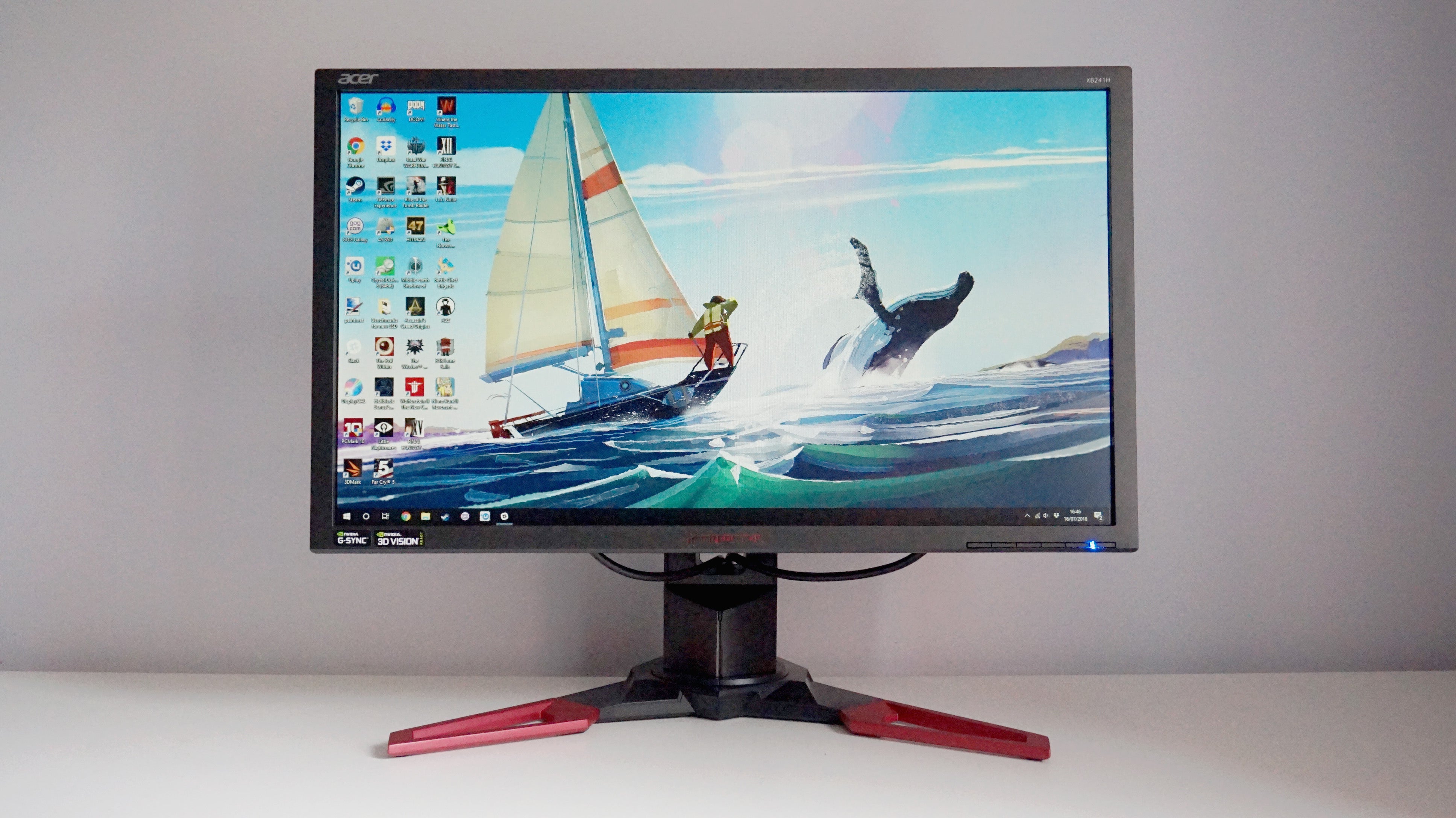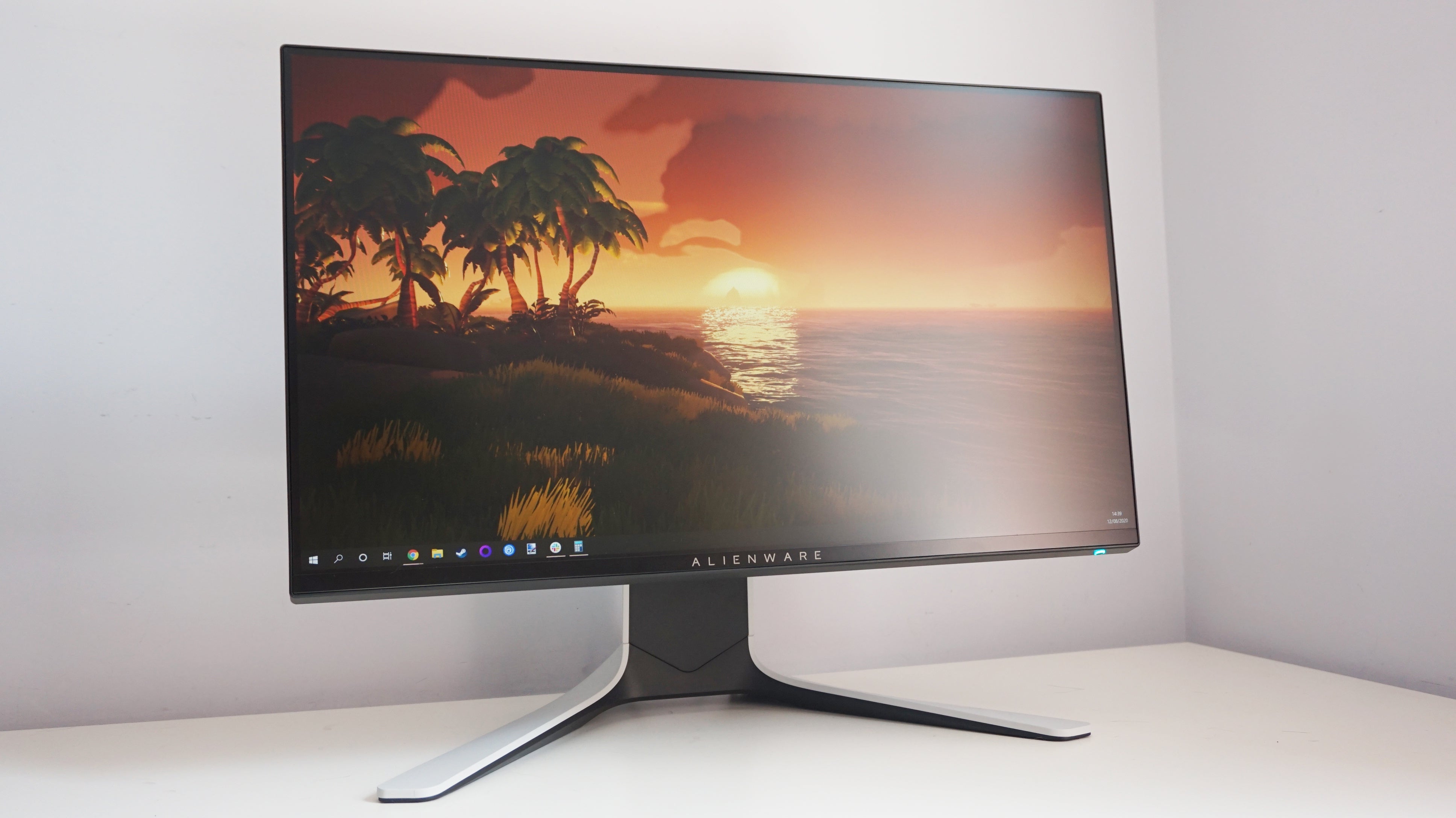Screen-tearing can be one of the big downsides of playing games at high refresh rates. It tends to happen when your graphics card is putting out more frames than your monitor can handle, causing it to display two images at once. Adaptive sync technologies like G-Sync stop all that from happening by automatically adjusting your monitor’s refresh rate to the number of frames coming out of your graphics card, ensuring smooth, tear-free gaming at all times. Since G-Sync belongs to Nvidia, it probably goes without saying that you’ll need an Nvidia graphics card in order to take advantage of a G-Sync gaming monitor, so make sure you’ve got the right GPU inside your PC before you buy.
The best G-Sync gaming monitors
Acer Predator XB241H Alienware AW2521H Acer Predator Z35p AOC Agon AG353UCG Asus ROG Swift PG27UQ
Acer Predator XB271HK
An oldie, but a goodie, the Acer Predator XB241H is one of the all-time great G-Sync gaming monitors. Its TN panel is one of the most colour accurate screens I’ve ever tested, and the option to overclock its 144Hz refresh rate all the way up to 180Hz using its onboard menu system gives you plenty of frames to squeeze out of your favourite games. While perhaps not as sleek and modern as newer G-Sync gaming monitors, the XB241H continues to hold its own against its more recent competitors. Sure, it’s a lot more expensive than other 24in 1920x1080 monitors out there, but when it comes to entry-level G-Sync screens, the XB241H is a tough act to beat. What we like: ✔️ Exceptional colour accuracy ✔️ Good value for money ✔️ Available in a wide variety of screen sizes and resolutions Read more in our Acer Predator XB241H review
Alienware AW2521H
The G-Sync cousin of the Alienware AW2521HFL, the Alienware AW2521H is arguably one of the best and most fully-featured G-Sync monitors out there. It’s expensive compared to other 1080p G-Sync monitors out there, but sadly that’s the price you pay for getting one with Nvidia’s proprietary G-Sync tech and a fancy 360Hz refresh rate. It’s also got Nvidia’s Reflex Latency Analyzer built-in as well, letting you see exactly how much time it takes for Reflex compatible mice to register your actions onscreen. This feature will probably only be useful if you play a lot of competitive shooters (and have the right mouse), but if you crave getting an edge over your opponents, the AW2521H is one of the most responsive gaming monitors around today. Just make sure you connect it to your PC via its DisplayPort input, otherwise you’ll be limited to just 240Hz over HDMI. Alternatively, if you don’t fancy paying that much but still want a fast panel with that distinctive Alienware design, then its 240Hz FreeSync (and officially certified G-Sync Compatible) sibling, the AW2521HFL is available for a lot less - just £289 / $380. You don’t get the Nvidia Reflex stuff with the HFL, but this is still an excellent 240Hz monitor with top notch colour accuracy if you want to save a bit of cash. What we like: ✔️ Distinctive design ✔️ Great set of ports and connections ✔️ Ideal for competitive esports
Acer Predator Z35p
Ultrawide G-Sync monitors are a bit of a dying breed now that Nvidia’s entry-level G-Sync Compatible tier has come in, as the sheer cost of buying an ultrawide monitor is pretty high in the first place without the added burden of the dreaded full-fat G-Sync tax. Indeed, it’s partly due to its age that the Acer Predator Z35p is now one of the happy(ish) exceptions in this case, as this ultrawide G-Sync monitor is now a lot more affordable than it was at launch. It’s still a little hard to come by right now, but it’s a fantastic screen if you can find one. Not only is its curved VA panel absolutely gorgeous, with rich, vibrant colours, but it’s also got excellent contrast and deep, inky black levels. The Z35p’s 100Hz refresh rate (or 120Hz, if you overclock it using the monitor’s onboard menu system) isn’t as high as slightly more modern ultrawide G-Sync screens, but in my eyes that’s still more than enough given its demanding resolution. Throw in its height-adjustable stand and bevy of USB ports, and it’s one of the best ultrawide monitors around. What we like: ✔️ Highly colour accurate panel ✔️ Understated design ✔️ Lots of USB ports Read more in our Acer Predator Z35p review
Asus ROG Swift PG27UQ
The Asus ROG Swift PG27UQ is one of the best G-Sync gaming monitors out there. It’s so good, in fact, that Nvidia have given it their special G-Sync Ultimate rating, which means it’s a G-Sync screen with eyeball-searing HDR built-in, as well as the ultra low latency and rich colours you get on a regular G-Sync screen. Indeed, with a peak brightness of over 1000cd/m2, the ROG Swift PG27UQ can deliver a premium TV-grade HDR experience you just don’t get on other HDR monitors, thanks in no small part to its hundreds of individual backlights to help push those bright spots to their absolute limit. It makes for a great gaming experience, although it will cost you a small fortune in the process. If close to two grand isn’t quite within your budget, we’d also recommend considering the Acer Predator X27 as well. This has the exact same panel as the PG27UQ, but it’s slightly cheaper due to having fewer RGB lights in the stand and back of the screen. What we like: ✔️ Best in class HDR ✔️ Rich, vibrant colours ✔️ Superb contrast and low black levels Read more in our Asus ROG Swift PG27UQ review
AOC Agon AG353UCG
Much like the Asus ROG Swift PG27UQ, the AOC Agon AG353UCG is another fancy pants G-Sync Ultimate screen - only here it’s in a lovely 21:9 ultrawide format. Yep, this monitor also costs an absolute bomb compared to some of the other G-Sync monitors on this list, but if you want a monitor that’s got all the bells and whistles, the AG353UCG is the one to buy. Alas, it’s not readily available to buy in the US right now, but this is one premium gaming monitor for those of you with deep enough pockets. Its slim, scarlet stand cuts a striking profile on your desk, and its curved VA panel is just stunning, producing rich, vibrant colours straight out of the box. Naturally, you’ll need a pretty powerful graphics card to fill out its whopping 200Hz refresh rate when playing games at 3440x1440, but if you crave the ultimate ultrawide HDR experience and have a rig powerful enough to do it justice, then the AG353UCG is well worth considering. What we like: ✔️ Stunning design ✔️ Eye-popping HDR ✔️ Superb colour accuracy Read more in our AOC Agon AG353UCG review
Frequently asked questions
What to look for in a G-Sync monitor?
The great thing about buying a G-Sync monitor is that they’re all tested to the same high standards internally at Nvidia, meaning one G-Sync experience should be exactly the same as any other. As such, the only thing you really need to look out for when buying a G-Sync monitor is what kind of refresh rate you want. 144Hz is arguably the most common refresh rate these days, but 165Hz and 240Hz monitors are becoming increasingly more affordable as well. Natuarlly, you’ll need a reasonably beefy graphics card to play games at those kind of speeds, but most competitive games and online shooters can fill those refresh rates pretty easily even on low-end GPUs.
Otherwise, you should look for all the other regular things you’d normally look for when buying a gaming monitor. You’ll want to make sure it has a height-adjustable stand so you can get a good and comfortable viewing angle, and ideally you’ll want one with a colour accurate screen to help games look their best. All the monitors in our list above have been tried and tested in-house here at RPS, so you can be sure all of these screens will look top notch once you get it on your desk.
G-Sync or FreeSync display, which is better?
The G-Sync vs FreeSync debate has raged on for years and years, and both technologies have pros and cons. From a purely technical point of view, G-Sync is the clear winner, as it provides a much better, and more consistent gaming experience than what you’ll find on a FreeSync display. You get smooth tear-free gaming at all frame rates, not just a limited range from 40-odd fps upwards, and G-Sync also helps to reduce input latency as well, making twitchy competitive games feel more responsive. G-Sync displays are also tested internally by Nvidia to make sure they meet certain colour standards, too, which doesn’t happen with FreeSync screens. As such, you always know what you’re getting with a G-Sync monitor, and it’s a seal of quality as much anything else.
The downside is that G-Sync monitors are a lot more expensive. It’s a hard sell at the best of times, and prices only get more expensive the further you move up the sizing scale. If you’re strapped for cash, the next best thing is to look out for an officially certified G-Sync Compatible display instead.
What does G-Sync Compatible mean?
If a monitor is G-Sync Compatible, it means that both AMD and Nvidia graphics card owners can take advantage of its variable refresh rate technology. Previously, AMD FreeSync screens and Nvidia G-Sync screens only worked with their respective graphics card families, but when Nvidia introduced basic adaptive sync support for all of their GPUs in 2019, it meant that all AMD FreeSync screens suddenly became G-Sync Compatible monitors as well.
In short, G-Sync Compatible screens let Nvidia GPU owners get the same variable refresh rate experience as you would with an AMD card. It’s a somewhat limited experience compared to a full-fat G-Sync screen. You’ll only get tear-free gaming within the same limited frame rate range as that monitor’s FreeSync implementation, for example, and you don’t get any of Nvidia’s extra ultra low latency and motion blur technologies and factory colour calibration either. But it provides a simple, basic enough experience that’s better than nothing - and one that’s a heck of a lot cheaper than the real thing, too.
However, since FreeSync monitors aren’t tested to the same standard as full-fat G-Sync screens, it does mean there are some G-Sync Compatible monitors out there that don’t play as nicely with Nvidia GPUs as others. That’s why Nvidia have their own list of officially certified G-Sync Compatible monitors, which is constantly being updated and expanded as they get more monitors in for testing. Rather unhelpfully, a lot of retailers have taken to calling all FreeSync screens G-Sync Compatible, regardless of whether they’ve got Nvidia’s stamp of approval or not. As such, if you’re thinking about buying a G-Sync Compatbile monitor in order to save a bit of money, make sure you do your research first to make sure it’s going to provide a good experience.




